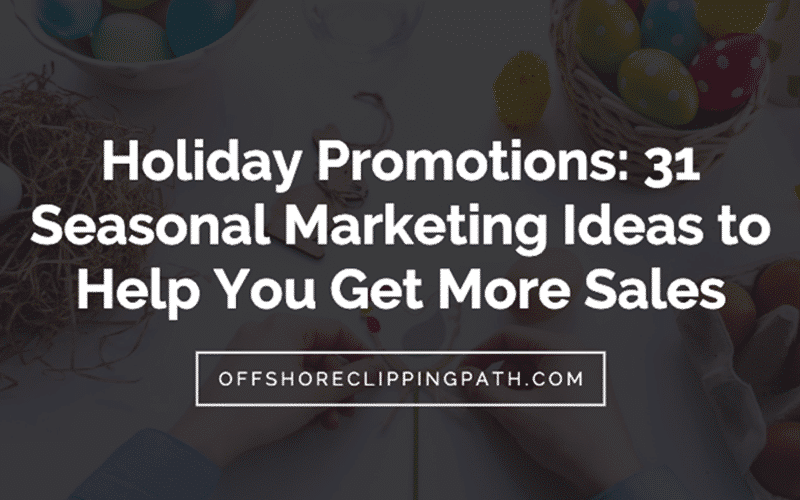When we say we’re committed to helping you grow your business, we mean it. In this article, you will get some great holiday promotions ides!!
After all, the more sales you generate out of your ecommerce store, the more your business thrives.
And the more your business thrives, the more likely you are to work with us.
It’s a win-win for all of us, really.
That is why we are bent on helping you take your ecommerce sales to nauseous heights.
With that being said, what better way to grow your sales than to leverage the holidays.
Did you know that In 2021, holiday retail sales were forecasted to amount to over $886.7 billion?
#mindblown!
The figure is a dead giveaway of how much money there is to be had during the holidays.
And so the question becomes, will you get your slice of the proverbial holiday sales pie? Or will you be missing out on all the sales to be had out of the holiday rush?
We don’t want you to experience the latter.
That is why we’ve put together this m-a-s-s-i-v-e holiday promotions guide that contains over 30-holiday marketing tips so you can cherry-pick which ones will work best for your store — the ones that will help you generate TRUCKLOADS of sales.
Do you like what you’re reading so far?
Let’s hop right in. 🙂
What you’ll learn in this article
- 1 31 Seasonal Marketing Ideas to Help You Get More Sales
- 1.1 1. Spy on your competitors
- 1.2 2. Connect with a social cause
- 1.3 3. Add a countdown timer
- 1.4 4. Collect data about your shoppers
- 1.5 5. Use memes to generate audience engagement.
- 1.6 6. Offer discounts
- 1.7 7. Run events or webinars
- 1.8 8. Show customer reviews
- 1.9 9. Create video tutorials about your products
- 1.10 10. Recommend relevant products
- 1.11 11. Add scarcity elements based on the holiday
- 1.12 12. Get a mom or dad to endorse your product
- 1.13 13. Create a buying guide
- 1.14 14. Interview influencers
- 1.15 15. Offer special discounts specifically for new customers
- 1.16 16. Publish a round-up post
- 1.17 17. Create an app for your ecommerce store
- 1.18 18. Offer free shipping
- 1.19 19. Split test
- 1.20 20. Give freebies
- 1.21 21. Choose the right platform in your holiday promotion
- 1.22 22. Monitor the product’s trend
- 1.23 23. Go to Q & A sites
- 1.24 24. Personalized holiday-themed emails
- 1.25 25. Create compelling headlines by using headline analyzer tools
- 1.26 26. Be mindful of cart abandonment
- 1.27 27. Use paid ads
- 1.28 28. Leverage pre-holiday rush
- 1.29 29. Use emotion-evoking words that paint a mental picture
- 1.30 30. Run contests
- 1.31 31. Go to forums
- 2 What’s next?
31 Seasonal Marketing Ideas to Help You Get More Sales
1. Spy on your competitors
There are a handful of ways to spy on your competitors. For starters, you can follow them on Facebook, so their ads will show on your feed.
From there, you just need to be mindful of their ads by checking its performance (e.g., shares, comments, likes, etc.). Once you see an ad with a decent performance, you can check out their ad copy, offer, and the type of creative they’re using.
Here’s an example ad I found on my Facebook feed.
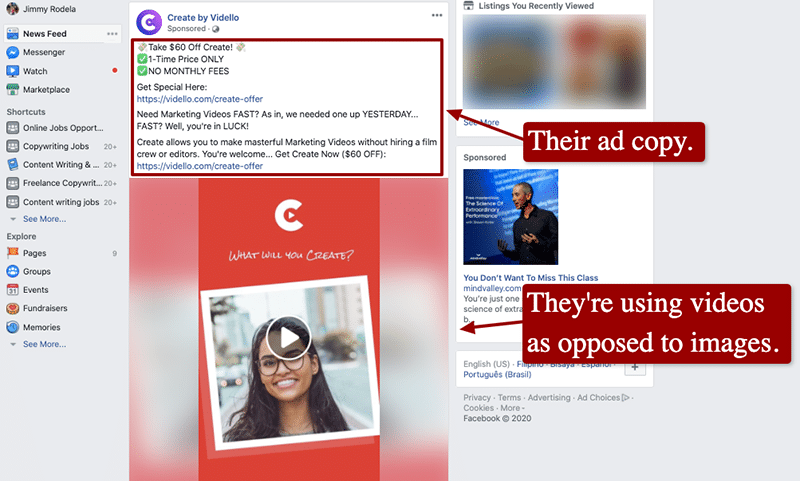
As you spy on your competitors’ ads, you gain valuable insight into how you should run your ad without you spending on research.
Connecting to a cause can boost your value in the eyes of your target audience. This phenomenon is called cause marketing.
It’s a fantastic way to show potential buyers that your company cares. It works even better when used during the holidays.
News of companies donating to the needy pulls heartstrings. You can even tie some of the profits from your goods to a cause.
Many of us have bought goods that claim to give some percentage of their profits towards a good cause.
Giving a bit of your profits out will endear your company to a lot of people and will lead to more sales.
3. Add a countdown timer
Countdown timers are perfect for compelling your audience to take immediate action on your offers.
Because your items or your discount offers are only available for a limited time, your customers won’t procrastinate when buying.
Here’s how a countdown timer looks when applied to product pages.
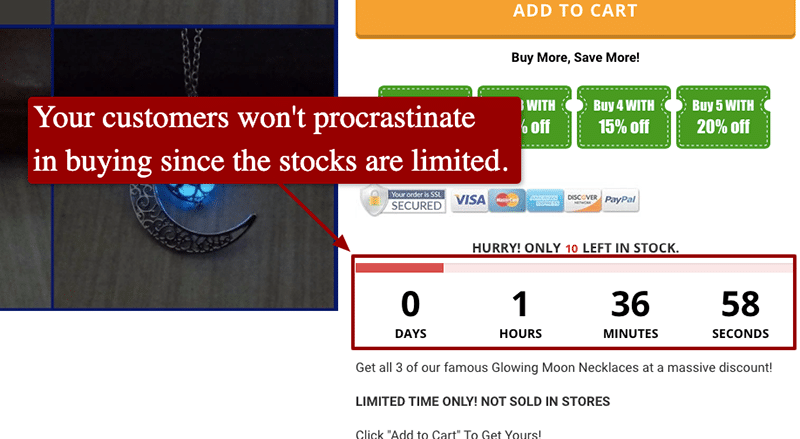
The timers will compel your audience to make the purchase immediately since they run the risk of losing the opportunity to purchase your product (or avail of your special offer).
4. Collect data about your shoppers
The importance of data in any business venture, especially a marketing campaign, can never be underestimated.
You may already know who your target customers are, but during the holiday seasons, even more detailed research needs to be carried out.
What do people in your customer’s age or general pay grade buy during this season? Who do they shop for? What kind of stores are they likely to visit?
These sorts of questions usually lead to more questions like why are these customers drawn to the stores they shop at? What are these stores doing that you’re not?
Optimize your business according to the answers and you are bound to see your sales spike.
You can even check your competitors’ websites to see from which countries their customers are coming from and which ad networks they’re using. You can use an online tool like Similarweb to pull this off.
I ran Amazon.com through its platform as an example. Here’s how the results looked.
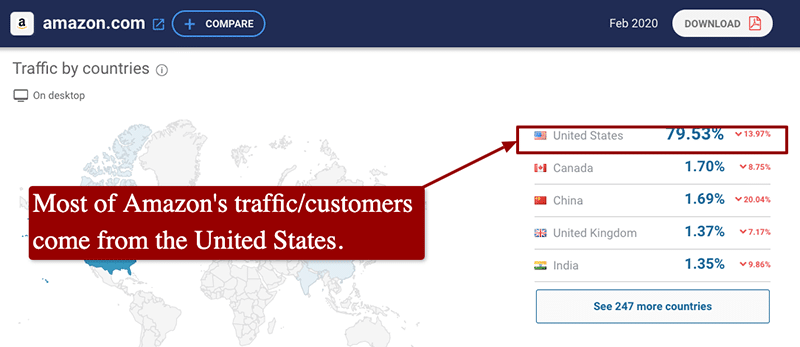
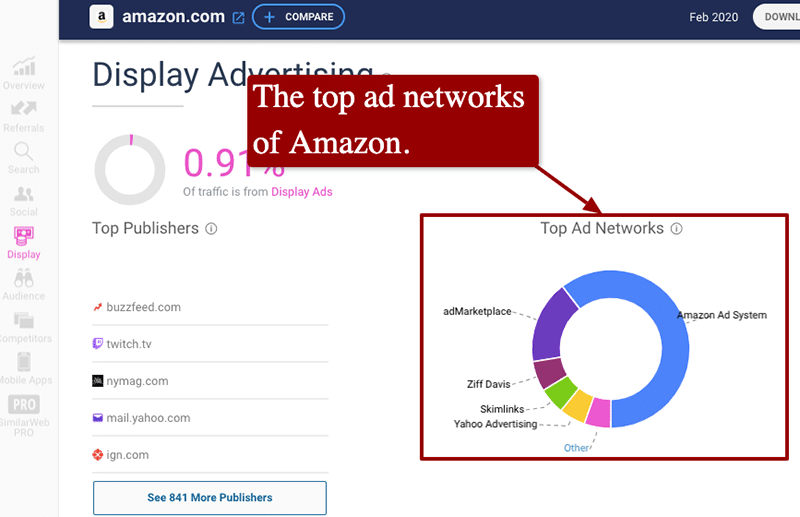
These are just some of the many data you can obtain about your competitors through Similarweb.
5. Use memes to generate audience engagement.
When you make your audience laugh — or smile, even — they tend to put their guards down.
That’s why memes are awesome.
They are such effective tools at helping you build relationships with your customers.
As you catch their attention, make them laugh, and bring them to your product pages, they are more likely to buy your products.
What’s more, there are a lot of holiday marketing-related memes online.
You can go to Google images, type “holiday marketing memes” and get inspiration from the countless memes you can find.
At that point, you can start creating your own meme that relates to your audience and your products.
6. Offer discounts
There is a reason why established ecommerce stores use discounts — they work like m-a-g-i-c!
Here’s an example where Lazada offered a 70% discount on one of their make-up items.
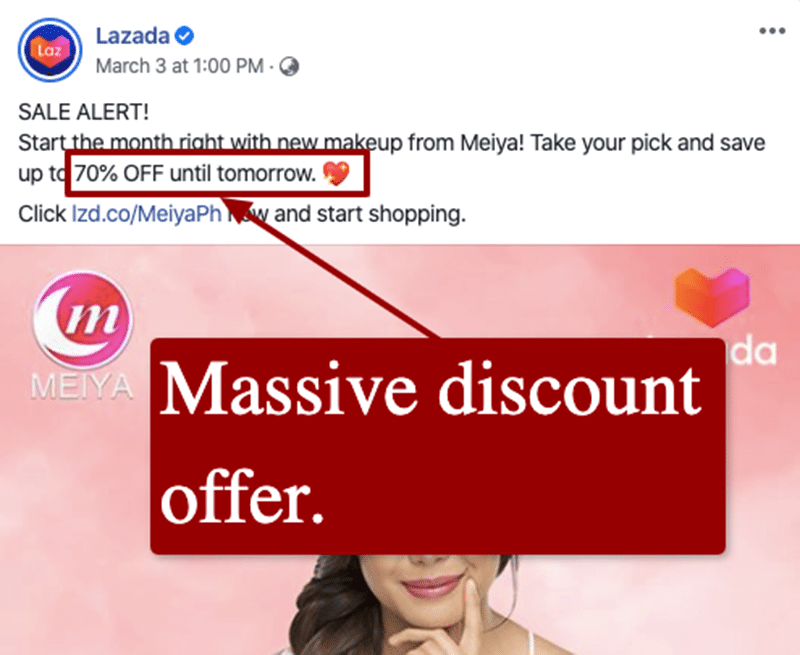
Especially during holidays, these discount offers are sure to catch the attention of your audience, especially if they’re already into buying the product that you’re selling — in our example’s case, make-ups.
7. Run events or webinars
This is a great way to stir up interest for your products.
When running an event or webinar, you have to create value for your audience that is linked to your products.
Doing this will invariably increase the popularity of your products among your target audience and make it much easier to convert on-the-fence customers.
By the time your event or webinar is over, your audience may feel they need that product. And voilà, there’s a sale.
8. Show customer reviews
Showing customer reviews is one of the best holiday marketing strategies that ecommerce entrepreneurs use.
It’s so effective that Amazon is even using it. Check this out.
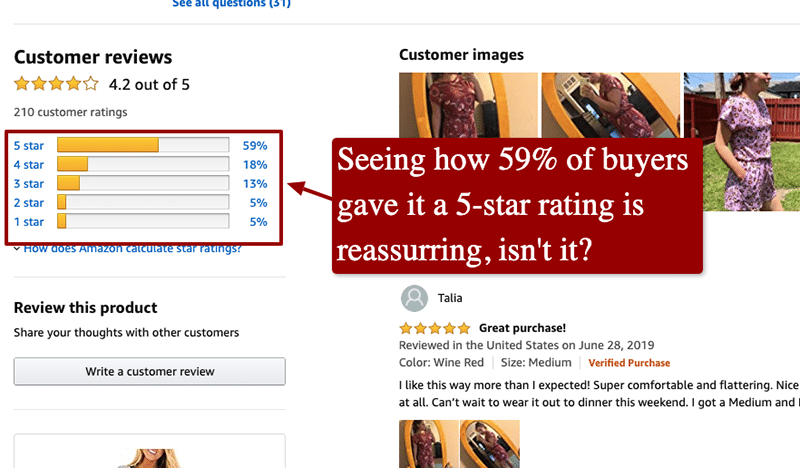
Seeing the positive customer reviews can help remove whatever doubts your customers have about buying, nudging them towards clicking your “Buy Now” buttons.
9. Create video tutorials about your products
Even if you’re selling pencil sharpeners, razor blades, or rubber bands, it’s still an excellent idea to tell people why and how they should use your products.
A video tutorial, especially when done uniquely, even has the capability to draw in more customers than the actual product.
Some of these customers might even take it upon themselves to share the video.
This will create that much-coveted organic traffic, which exposes your products to a broader audience and more potential buyers.
10. Recommend relevant products
Because your customers are already on your site, there’s a good chance they’re interested in buying something.
That’s great and all, but wouldn’t you benefit more if you took further advantage of their initial interest to buy?
That’s where your product recommendations come in.
You can add a “Frequently Bought Together” section on your website, so your customers can buy matching designs or products that complement the product they originally thought of buying.
Here’s how a reliable and trustworthy ecommerce company like PoshPeanut.com showed their product recommendations.
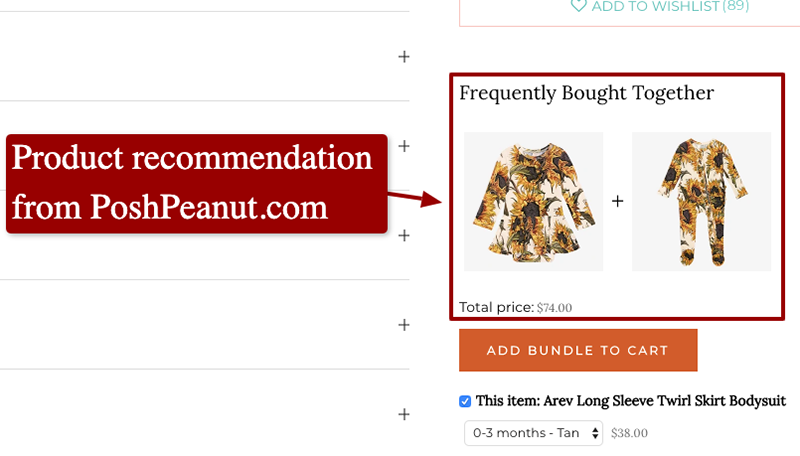
Because your customers’ frame of mind is already into buying, there’s a good chance they’ll buy your recommended product.
Using this strategy in your holiday promotions will help you get more mileage out of the transactions your customers make.
11. Add scarcity elements based on the holiday
There is no better time to use FOMO (fear of missing out) to market your products than during holidays.
Scarcity marketing uses the buyers’ fear of missing out on great deals or items to pressure them to buy a product.
Sounds underhanded?
It may be, but brands like McDonald’s, Starbucks, and Amazon use this tactic.
Here’s an ecommerce store offering a special discount specifically for Spring.
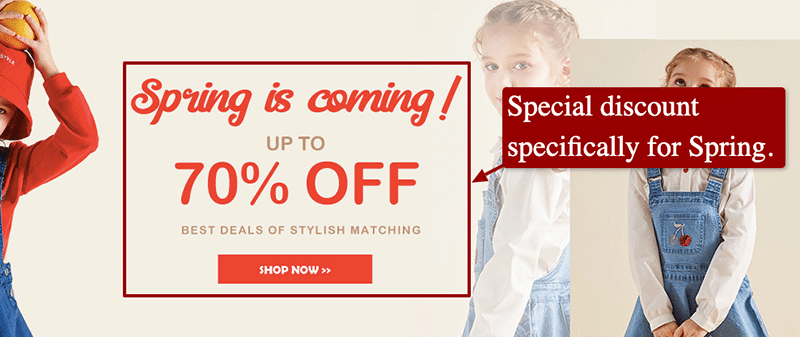
If you were the customer, can you imagine how keen you’d be at clicking the “Shop Now” button if Spring were about to end?
Putting sentences like “Discounts only available while stock lasts,” or maybe, “closing for the holidays soon,” create a sense of urgency and spur your customers to buy earlier.
12. Get a mom or dad to endorse your product
One of the best holiday social media marketing ideas ecommerce store owners can run is to get moms or dads to promote their products.
There’s something different about a mom or dad (or someone who exudes that parent vibe) endorsing your product.
Some people have this nurturer vibe to them, and so, having them recommend your product may make your products come across as trustworthy in the minds of potential customers.
People want to buy goods they feel they can trust.
If a parent, who is a generally trustworthy person, actively advertises your products, people will feel more inclined to buy.
13. Create a buying guide
A buying guide, when done right, can help your product look even better. A buying guide is basically an instruction manual for buying certain products.
Let’s say you’re selling a blender.
A buying guide generally contains factors to look for when buying blenders, how to test your blender, what and what not to do with your blender, etc.
When written correctly, it can make it evident that your blender is the best of the best. However, you need to be mindful of your guide’s tone, otherwise, it will only look promotional.
14. Interview influencers
Influencers (on social media or otherwise) can do a lot for your holiday ecommerce sales.
A survey conducted by Annalect and Twitter showed that 49% of consumers relied on influencers for product information.
That’s how effective influencers can be when it comes to growing your sales.
Look for influencers with an audience that includes your target market.
When you find one, you can start collaborating with them where they will promote your products, and you’ll give something that’s of value in exchange.
15. Offer special discounts specifically for new customers
Show your new customers some love by giving them irresistible offers for buying on your site.
You can offer cash backs, discounted rates, or coupons.
Here’s how Patpat.com, an ecommerce store that specializes in deals for moms and kids, presented their special offers for their new customers.
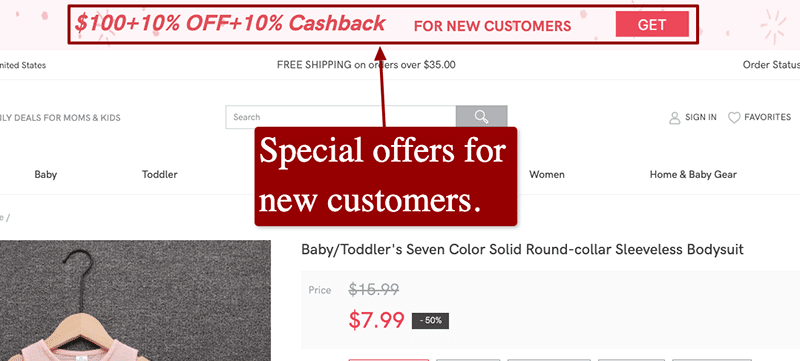
With this holiday marketing strategy, your new customers are incentivized to take action on your offers.
16. Publish a round-up post
People love to hear from the experts. In a world filled with misinformation, there’s nothing like hearing information from someone qualified.
A round-up post gives people that feeling.
Despite the countless round-up posts published on the World Wide Web, it remains relevant because people are never going to be tired of hearing expert opinions.
Your round-up post doesn’t even have to be complicated. You can just send a question to various experts and post their answers.
The most crucial factor is that your participants must be experts in your niche in every sense of the word.
17. Create an app for your ecommerce store
An app gives your goods a level of accessibility that a website doesn’t. It also allows for a better user experience.
Through your app, you can track your users’ searches and offer products according to past activities.
There’s no end to the advantages of having an app.
Having one makes your brand look more established and trustworthy.
It also allows you to address your customers’ needs more effectively.
And you have your customers’ mobile screen all to yourself — which allow you to sell better.
18. Offer free shipping
‘Free’ evokes a much better response than the word ‘discount.’ Anything free makes people less guarded. And free shipping is a massive deal to most people.
Even if it’s not, having that little expense shaved off, can make more people more inclined towards your product over the competition.
Offering free shipping on your products for the holidays is an excellent strategy because the holidays are a rather expensive period for lots of people.
Taking shipping off their expenses may make your company look like the best option to buy from.
Here’s how AliExpress presents their free shipping offer.
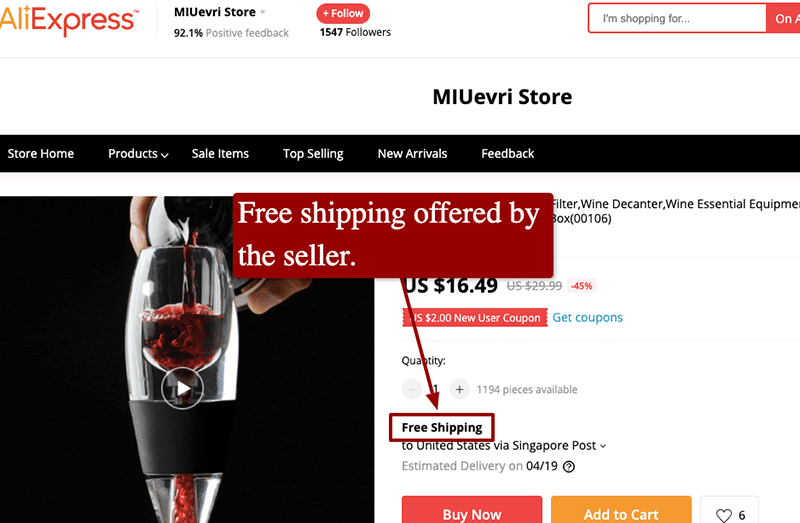
When you offer free shipping, you’ll have a better chance of closing the sale.
19. Split test
A split test is a great way to research variables during the holidays. It’s basically an experiment seeking an audience’s reaction to something.
This ‘something’ could be anything —a headline, a change in processes, user interactivity, ad creatives, products, etc. You can even test the audience itself.
The results of split tests can be extremely beneficial. With it, you can uncover which products or marketing elements are performing poorly.
With that information, you can remove whatever elements aren’t bringing your meaningful results so you can invest your resources on those that do.
20. Give freebies
Like we said before, the word ‘free’ makes everyone’s ears perk up. It’s no different during the holidays.
With everyone spending so much on gifts, they’d undoubtedly be even more interested in something free.
You can incentivize people to market your products by doing giveaways on places like social media.
Then, when the person has their new product, you can attempt to get them to buy a higher version of the item (AKA upselling) or get them to buy another product (cross-selling).
Another strategy is you’ll offer them something for free when they buy from you. Check out what this store did.
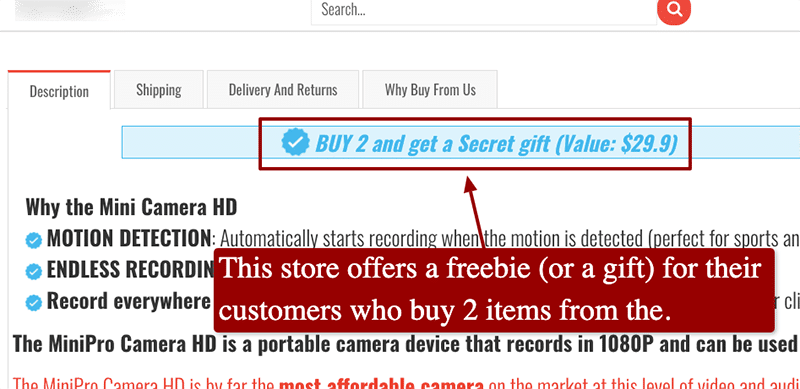
Because the store offers a free gift for people who’ll buy two items from them, the customers are encouraged to buy more.
21. Choose the right platform in your holiday promotion
Your marketing campaigns are going to be absolutely useless if you run them on platforms where your target market can’t see them.
You’ll be wasting your resources, time, and money if you market on platforms where your customers aren’t really present.
The only way to avoid this is through extensive research of your target market. Who are they? What social media do they use? Who influences them?
The answers to these questions will provide the foundation on which you’ll build an effective holiday marketing campaign.
As you uncover which platforms your audience are hanging out, and the platforms where they aren’t really present, you can focus your marketing efforts on the former — helping you optimize your marketing spend.
22. Monitor the product’s trend
Google Trends is one of the most straightforward tools that you can use to see how trendya product is.
Through the data it shows, you can surmise whether or not there is enough interest for certain products.
Here’s an example of how Google can show you data on how trendy a search term is.
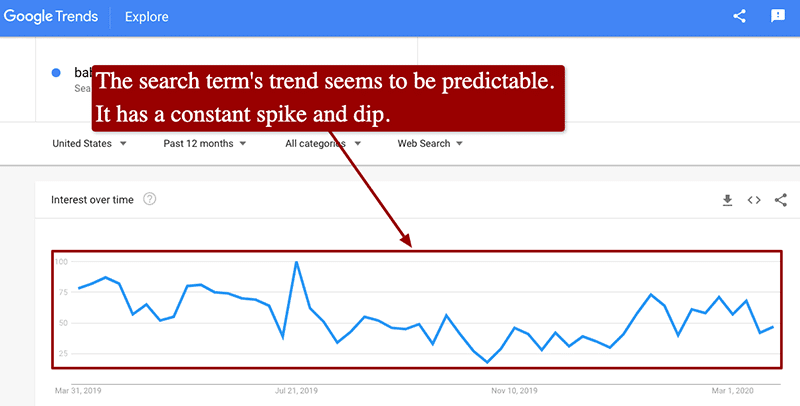
I typed in “baby rompers” and that’s the result Google Trends came up with.
It shows us that baby rompers aren’t “out.” And that if you started selling it, there is still some interest from your audience.
23. Go to Q & A sites
With the help of Q & A sites, you can uncover product ideas that will resonate well with your audience.
For example, let’s say there’s a question raised on the platform about “What do you hate about Easter Sunday?”
As you can probably imagine, people are bound to comment on things that they are frustrated about.
From there, you can check out which answers garnered the most upvotes, shares, or comments.
These will act as your social validation.
You can then add products to your ecommerce store that addresses these pain points. Also, you can reply to their comments strategically sharing how your product can help them with their problems.
24. Personalized holiday-themed emails
Getting confirmation that a person is thinking about you warms your heart.
It’s a sign that you were remembered and this means more to a lot of people than any discount or deal.
Personalizing your emails in the simplest form can make your company dear to a customer and ensure their loyalty.
You don’t even need to go to the extreme when writing your emails, otherwise, it’ll look forced or fake. Sometimes, simply using a person’s name is enough.
Sending a customer a happy holiday email with a personal touch will not cost you much in terms of expense.
However, it might make your customers feel like they matter to your company. It’s an awesome way to build loyalty. And of course, generate sales during holidays.
25. Create compelling headlines by using headline analyzer tools
If your headlines are carefully crafted, you’ll have a better chance of influencing your audience into clicking your product pages, blog posts, or even your offers.
It all boils down to how compelling your headlines are.
The good news is, there are headline analyzer tools that you can use so you have a benchmark of sorts to figure out how compelling your headlines are.
Here’s CoSchedule’s headline analyzer and the result it gave after I typed in the sample headline, “Stunning Fireman Shirts You Absolutely Need to Buy.”
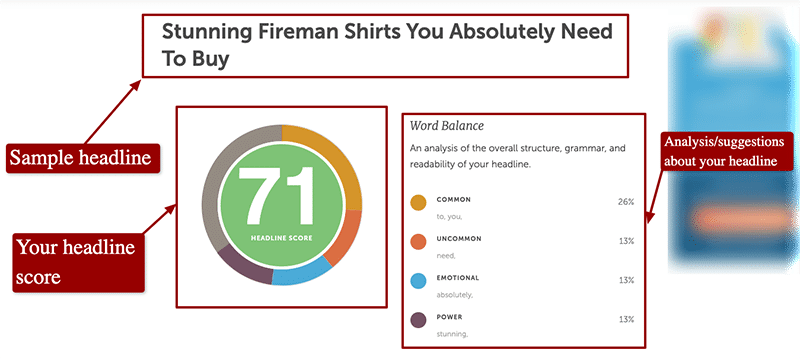
You can already see that the headline has a decent score. However, since you can see the analysis of your headline, you can make further improvements to it.
26. Be mindful of cart abandonment
Cart abandonments are pretty typical, but still heartbreaking.
It’s frustrating to see your products getting added to your audiences’ virtual shopping carts, only for them to click away and not push through with the purchase.
It’s your job to find out why people are abandoning their shopping carts.
To do this, you can set up an automated conversation with the customer to gently inquire about why the cart was left and to encourage them to buy.
You can also check your website or app for a glitch that could’ve made the customer abandon the cart.
27. Use paid ads
This is the most straightforward way of drawing attention to your company and products during the holidays.
You just need to create and publish an ad, and you’re pretty much good to go.
With this strategy, you can generate thousands of sales even on your first day running the ad if you know what you’re doing.
Your ad creative needs to be spot on, your offer, your audience targeting, etc.
The downside with running paid ads is they are often costly.
What’s more, when you turn off your ads, you’ll almost immediately stop receiving unique traffic.
28. Leverage pre-holiday rush
A few days before any holiday, there’s always a heavy flow of consumers. A few weeks before, that is the best time to start marketing and advertising your butt off.
You need to plan a marketing strategy to target these shoppers because they just might be your best buyers during the season.
On your website, start advertising deals and discounts. You can also start creating content for certain audiences like parents, lovers, etc.
If you have a physical store, make sure you’ve ordered enough stock. The signs advertising, discounts, and your brand name should be as clear as possible.
You need to look like you’ve got what your shoppers need.
29. Use emotion-evoking words that paint a mental picture
If you haven’t been integrating emotion-evoking words into your holiday marketing plans, then you’re leaving a lot of money on the table.
This is not the time to shy away from adverbs and adjectives. On every label and in every advertisement, you need to be as descriptive as possible.
This is most important in online advertising. People can’t touch or hear any of your products. The only thing they have is their sight and your words.
So make those words count by adding adjectives. Use words that can give them a picture of what it’s like to feel your product, how it’ll feel if they bought it.
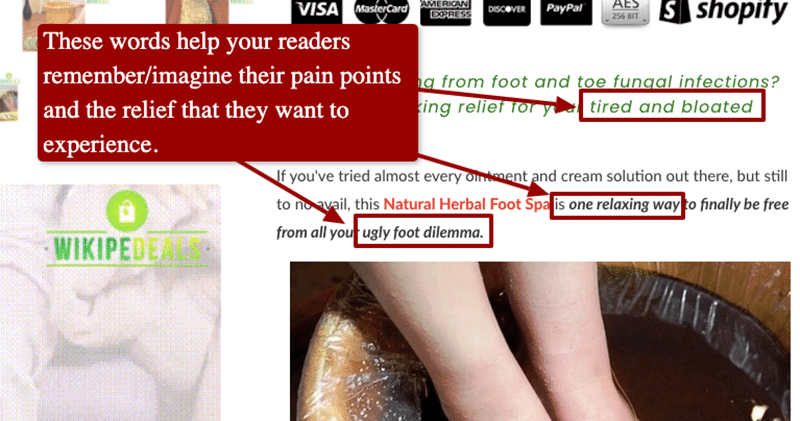
Words like loving, confident, astonishing, beautiful, secret, etc., evoke powerful emotions and mental images in your customers and make your product more appealing.
30. Run contests
When you run contests as part of your holiday promotions, you get better audience engagement, brand visibility, and more sales (among other things).
Imagine this…
Let’s say you’ll run a contest on Facebook where you’ll require your audience to tag three of their friends, share your post, and make a $1 purchase on any of your items, so they can join your contest.
Can you imagine how much views and engagements you’ll get out of your contest?
What’s more, if each of the contestants did buy from your store, then you’d have already garnered sales one way or the other AND also capture their email addresses so you can send them more offers in the future.
Pretty sweet, huh?
The key here is to make sure that your prize is enticing enough and for your contest dynamics to be straightforward and easy to do. If you get both of these down, then you’re likely to get good results out of your contests.
31. Go to forums
This is another way to create goodwill and establish brand loyalty with your customers.
Answering questions about your product or industry on forums can make your brand look more authoritative and accessible.
If you’re able to respond to questions, comments, and complaints related to holiday shopping, it can make you stand out amongst your competition.
Every customer likes to know they’ve been heard. You can even create your own forum, as like other reputable companies do.
What’s next?
Did you find the holiday marketing ideas shared in this guide helpful?
If you answered with a “yes,” then feel free to click the share button.
Also, if you need help with making your product photos look uber professional, then be sure to take advantage of our discount.
We’re currently offering a 50% discount on all our services. Cheers!
